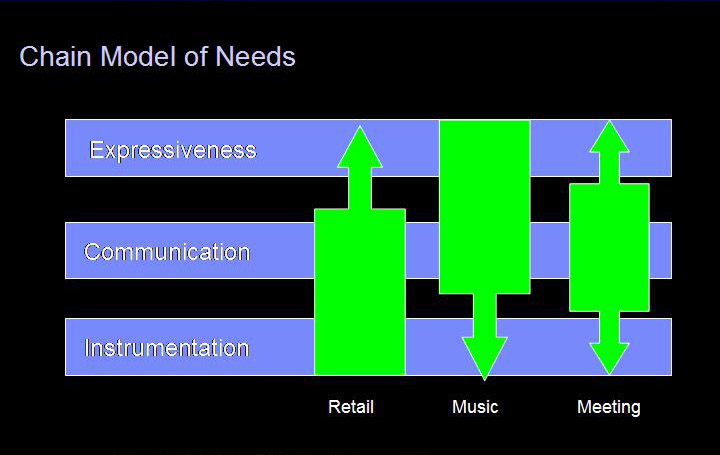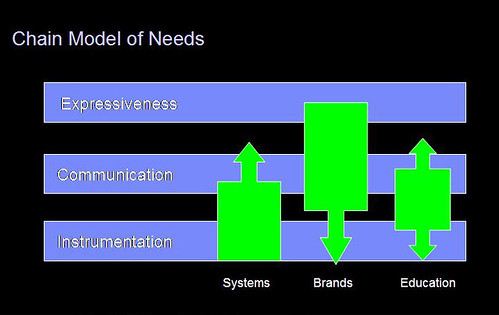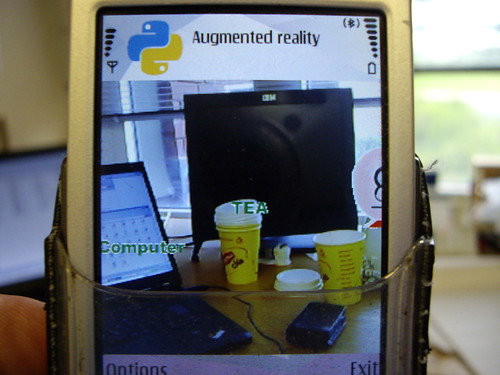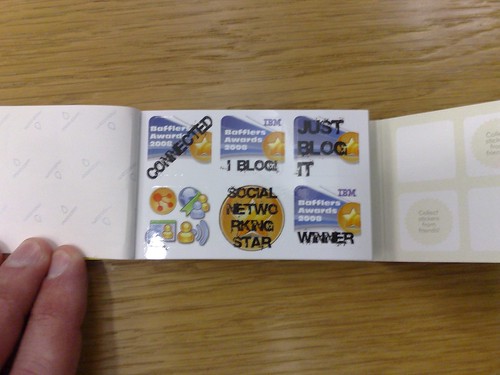I believe that many people are still looking at metaverses and not considering the wide spectrum of modes that the subject covers. Some of the potential reasons given for fear or suspicion are directed at the wrong end of the spectrum and hide the other deeper benefits that may be more comfortable for those people who are objecting.
I wanted to have some sort of spectrum that I could apply various business ideas, where already the business need exists but to be able to identify the key component that differs and hence some benefit can be seen or inferred or discovered.
The first element to this is a three layer model of where metaverses fit in and work
accidentally this is ECI, or ICE if reversed hence the title “Reverse ICE”
1. Expressiveness
This refers to the way that many early adopters and web2.0 people have come to metaverses. Just as Blogs, flickr, last.fm, twitter etc all allow a degree of personal expression the virtual worlds extend that expressiveness, how you dress, where you hang out, who you know, what you build, events you are seen to attend.
It is this expressiveness that causes the biggest shock to people who are not in the subset of people who do this. it is not wrong to not want to be expressive, but it can be viewed as the frivolous end of all this and the one that needs to be controlled in a business sense.
Expressiveness is the least measurable benefit, yet the one anecdotally we all benefit from the most. “I dont want to mess around creating an avatar” etc is a valid concern in the adoption or virtual worlds. It is also the one that is not seen quite so much in web1.0 where company information sites, shops etc are not about the users involvment in quite the same way.
2. Communication
This layer refers to the fact that metaverses are a communication medium, as are websites, blogs, powerpoint. User generated content whilst also blending with 1. above also are there as a commnuication vehicle. A picture says a thousand works so does a metaverse location in 3d say a million? We need to communicate in business with one another and around projects, with customers etc. This communication layer exists already in a variety of forms some more “efficient” than others
3. Instrumentation
This layer is the most comfortable for a company and in particular a large corporate. Instrumentation refers to the fact that there are things going on somewhere, in a business, in financial results, in a disaster situation etc that are all part of the information stack that drive business decisions. In many senses this is SOA(Service Orientated Architecture). The inbound and outbound services (whether technical implementations or not) are things about the business world, or social world that act as data, facts and decisions implemented.
With these three areas overlap I believe we can map certain types of business problem and see the parts that are newer, or brighter or more enhanced by virtual worlds or other solutions.

a. Retail
I would suggest that when retail is boiled down to having to shift product to customers the business flow would be as follows.
Instrumentation (How much have I got/What price to make profit) —-> Communication (advertizing, shops, salesforce) —-> Expressiveness (Engaging with a customer set, emotional involvement with a brand, customer loyalty and championing)
In pure web terms Instrumentation to Communication is clear, its putting products out there, simple clicks to buy. A small layer of expressiveness and brand engagement occurs, usually though other channels are used. Lifestyle, tv etc. Virtual Worlds offer a richer degree of expressiveness in that consumers may engage with the brand product, with each other and with members of the organization selling the product. The degree that this is needed depends on the product but the richness and depth comes from going past communication and engaging in the human need for expression. many brands already do this in several ways so as a channel do this more or better it would appear to fit.
b. Music/Art
I made this separate from retail in order to highlight that some industries and business do not flow in the same direction as the first examples.
Music, and examples of how MTV are operating at the moment in the web2.0/virtual world space follow a different pattern.
It starts with expressiveness (having an message, a feeling, a song) —-> this moves to be communicated in a variety of ways building a fan base. A loop occurs in that the fan base engages in expressiveness and commnuication too —> in business terms this then moves to instrumentation, selling records, songs, downloads, merchandise (the realm of the record company)
Virtual worlds are used to engages at the expressiveness stage, bands perform, fans attend bypassing some of the need for co-location. Successful bands become “mainstream” and appear on MTV an get record deals.
c. Business Meetings
This example is interesting as it starts in the middle to some extent.
Communication (There is a need to commnuicate/decide/inform/share in a formal sense) —> This leads to needing instrumentation from the business, data, results, powerpoints, evidence, business dashboard, KPI’s, threats from competitors. In regular business it might be considered that that is where the seriousness is, Just Communication and Data. However meetings of any sort have a degree of expressiveness. Business relationships exists, politics exist. awareness of others and understanding motivations and positions exists. Leadership is required. In most electronic media we use this is the thing we filter the most with phones, pure text etc. Some people only need this, only need th bare minimum (potentially because they already have a deeper insight) others need more immersion with other members of any meeting. Hence meeting face to face allows for this expressiveness (even it that is a poker face) to occur. Other electronic media turn down the detail. Virtual worlds allow for degrees of expression. The balance comes as a barrier to entry problem that some people can work a virtual room very well, other feel at a disadvantage. This is a threat to many people who have great social skills in real life but then feel they cannot translate them to any other platform or technology. I think this will dissappear over time but is a cultural problem.
Making the expresiveness that the more skilled communicators in real life need, easier to apply to the virtual world, and pulling in the instrumentation in an easier SOA fashion and delivering the answers out again are where we can make a big difference as a company I think.

d. System architecture/Data Centres/Buildings
This is a more pure mirror world/paraverse example.
This is about visualizing the data from instrumentation, where are my software elements deployed, which machine is not working, where are the power condiuts. Taking a location or state of a business or a chemical model and rendering it in 3d where appropriate does not really have to involve people or avatars. This is business/it dashboard territory. However in moving towards the layer of communication, to get the message across, drawing this in an immersive way to be experienced is what we try and do all the time. UML diagrams, design drawings, blueprints etc.
The interesting element again is that this is probably a very comfortable place for many technologists to consider things. It does not need a great layer of expression to be applied. However that expression can be there and can be used in a virtual worlds. Imagine two architects in a room discussing a design they will draw on boards, point, argue, agree, pull rank etc. This can and will also happen in a virtual world where such devices are available to express themselves. That expression does not have to be weird and cool clothing, or funky avatars, but pointing, moving, altering the environment, altering anothers point of view to show the effect of change.
e. Brand engagement is usually more about people dealing with levels of expression, in real life wearing the t-shirt, driving the car, mentioning the product in a blog post. I think it speaks less to instrumentation, though clearly if instrumentation is bottom line figures and business then it needs to. It just feel more decoupled. It may be the case in virtual worlds presence too. Enagage the passionate users, be part of the community first, not a hard and fast advertising of presence.
f. Education. This is traditional education, class, facts, teachers, pupils. Clearly this needs to deal with expressiveness, and it may be that the engagement that occurs with students wanting to be part of something is why we see such a growth in serious games.
As you can see I hope the normal expressive worries are often placed before the more solid business reasons of communication and instrumentation. We can engage people in those other layers without them having to worry about the expressive, but the expressive will come over time.
Many of us as early adopters flow around all these layers all the time, but a more directed approach for some may make it easier to accept. This may get over any mental barrier to adoption whilst we also need to sort out the technical barriers to adoption and make it easy to engage and for people to feel comfortable in that engagement.
Also this is by no means a hard and fast classification. It merely aims to place some elements of familiar business into some sort of context. A good business leader will more than likely be a strong personality and very expressive when rallying their people, whether that is for motivation or to deliver solid business messages to a wider audience. Those that seek to lock down this expressiveness and claim that business, politics etc are only a “serious” platform requiring only “serious” interactions may need to realize this is not a binary domain.
It seems that metaverse in particular, even more so than the text and pictures of the blog, challenge peoples notions of expressiveness. There may be a short term power base in business of people more akin to the traditional social networks and performance platforms, doing lunch, playing golf etc.
We had a good session recently discussing these points and it appears to work as a model for helping translate some of the business ideas. It is a high level model, with a lot of flexibility to explain many things. Being able to make a distinction between a type of business and the types of reasons for not doing certain enagegments is much mroe important now as people are gaining a degree of understanding as people as to why metaverses work, but now need to see where they fit in specific business areas.







